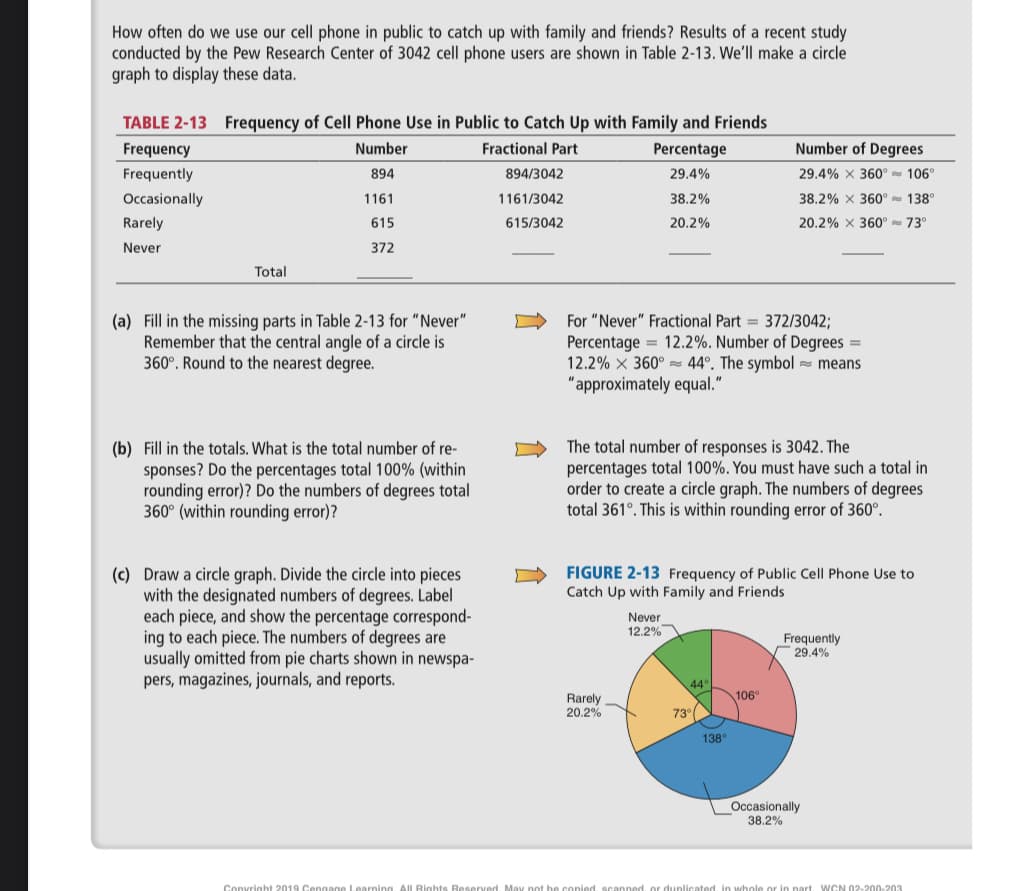(c) Draw a circle graph. Divide the circle into pieces with the designated numbers of degrees. Label each piece, and show the percentage correspond- ing to each piece. The numbers of degrees are usually omitted from pie charts shown in newspa- pers, magazines, journals, and reports.
(c) Draw a circle graph. Divide the circle into pieces with the designated numbers of degrees. Label each piece, and show the percentage correspond- ing to each piece. The numbers of degrees are usually omitted from pie charts shown in newspa- pers, magazines, journals, and reports.
Glencoe Algebra 1, Student Edition, 9780079039897, 0079039898, 2018
18th Edition
ISBN:9780079039897
Author:Carter
Publisher:Carter
Chapter10: Statistics
Section10.6: Summarizing Categorical Data
Problem 42PFA
Related questions
Question
Please answer part c, show work. Please be right. Thx.

Transcribed Image Text:How often do we use our cell phone in public to catch up with family and friends? Results of a recent study
conducted by the Pew Research Center of 3042 cell phone users are shown in Table 2-13. We'll make a circle
graph to display these data.
TABLE 2-13 Frequency of Cell Phone Use in Public to Catch Up with Family and Friends
Number
Fractional Part
894
1161
615
372
Frequency
Frequently
Occasionally
Rarely
Never
Total
(a) Fill in the missing parts in Table 2-13 for "Never"
Remember that the central angle of a circle is
360°. Round to the nearest degree.
(b) Fill in the totals. What is the total number of re-
sponses? Do the percentages total 100% (within
rounding error)? Do the numbers of degrees total
360° (within rounding error)?
(c) Draw a circle graph. Divide the circle into pieces
with the designated numbers of degrees. Label
each piece, and show the percentage correspond-
ing to each piece. The numbers of degrees are
usually omitted from pie charts shown in newspa-
pers, magazines, journals, and reports.
894/3042
1161/3042
615/3042
Percentage
29.4%
38.2%
20.2%
For "Never" Fractional Part 372/3042;
Percentage = 12.2%. Number of Degrees =
12.2% X 360° 44°. The symbol means
"approximately equal."
Rarely
20.2%
The total number of responses is 3042. The
percentages total 100%. You must have such a total in
order to create a circle graph. The numbers of degrees
total 361°. This is within rounding error of 360°.
FIGURE 2-13 Frequency of Public Cell Phone Use to
Catch Up with Family and Friends
Never
12.2%
44°
Number of Degrees
29.4% X 360°
38.2% X 360°
20.2% X 360°
73°
138°
106°
Frequently
29.4%
106°
138°
73°
Occasionally
38.2%
Copyright 2019 Cengage Learning. All Rights Reserved. May not be copied, scanned, or duplicated, in whole or in part. WCN 02-200-203
Expert Solution
This question has been solved!
Explore an expertly crafted, step-by-step solution for a thorough understanding of key concepts.
This is a popular solution!
Trending now
This is a popular solution!
Step by step
Solved in 3 steps with 2 images

Recommended textbooks for you

Glencoe Algebra 1, Student Edition, 9780079039897…
Algebra
ISBN:
9780079039897
Author:
Carter
Publisher:
McGraw Hill

Holt Mcdougal Larson Pre-algebra: Student Edition…
Algebra
ISBN:
9780547587776
Author:
HOLT MCDOUGAL
Publisher:
HOLT MCDOUGAL

Glencoe Algebra 1, Student Edition, 9780079039897…
Algebra
ISBN:
9780079039897
Author:
Carter
Publisher:
McGraw Hill

Holt Mcdougal Larson Pre-algebra: Student Edition…
Algebra
ISBN:
9780547587776
Author:
HOLT MCDOUGAL
Publisher:
HOLT MCDOUGAL